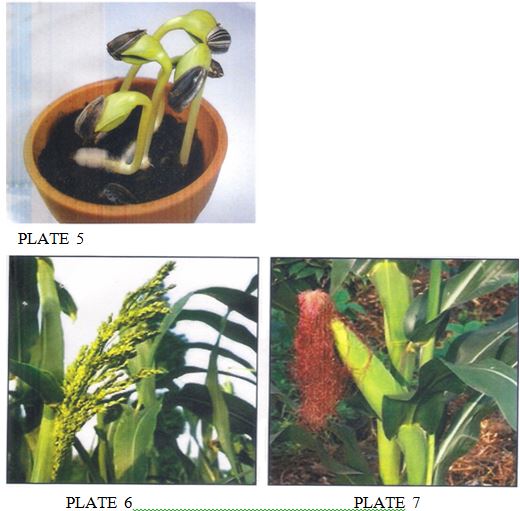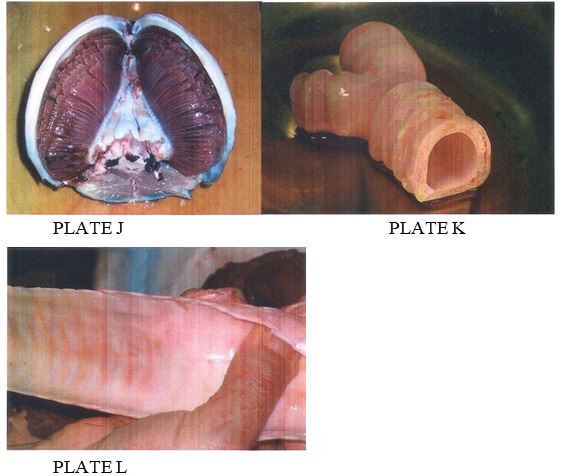Answer ALL the questions
Answers should be written in the spaces provided
- You are provided with the following
25ml Bromothymol blue.
Solution X.
A drinking straw.
2 test tubes.
10ml measuring cylinder.
A boiling tube.
Dilute hydrochloric acid.
Dilute sodium hydroxide.
- Place 2ml of Bromothymol Blue (B.T.B) in a clean test tube. Add dilute hydrochloric acid drop by drop and shake after each drop till there is a permanent colour change.
- State the resulting colour. (1mk)
- To the mixture obtained above, now add sodium hydroxide solution drop by drop until there is a colour change. Record your observation. (1mk)
- From your observations in (a)(i) and (a)(ii) above what is the nature of Bromothymol blue. (1mk)
- Place 10ml of fresh Bromothymol blue in a boiling tube. Using the drinking straw, bubble air through the bromothymol blue until there occur colour change.
- Record your observation. (1mk)
- What does the colour obtained in (b)(i) above suggest about the nature of the gas breathed out? (1mk)
- Rinse the measuring cylinder and use it to place 2ml of solution X in a clean test tube. Rinse the drinking straw used in (b) above and use it to bubble air through solution X.
- Record your observation. (1 mark)
- Suggest the identity of solution X. (1 mark)
- Suggest the identity of the gas that gave rise to the observation above. (1 mark)
- Name the physiological process in cells that leads to formation of the gas named in c(iii) above. (1 mark)
- Write down a word equation for the process named in d(i) above. (2 marks)
- What is the importance of the identified process in cells of living organisms? (1 mark)
- Place 2ml of Bromothymol Blue (B.T.B) in a clean test tube. Add dilute hydrochloric acid drop by drop and shake after each drop till there is a permanent colour change.
- Study the photographs and answer the following questions.
- The photograph in Plate 5 shows the germination process in a species of legume.
-
- Name the type of germination shown in the photograph. (1mk)
- Give a reason for your answer. (1 mark)
- Other than germination the seedling have shown some responses.
- Name two responses shown in the photograph. (2 marks)
- State one survival value of each of the response named above. (1 mark)
-
- Examine the photograph in Plate 6 and Plate 7 which show different essential parts of a flower of a species on two different plants.
- Name the flower parts shown in Plate 6 and Plate 7. (2 marks)
Plate 6
Plate 7. -
- Name the phenomenon described in the statement above. (1 mark)
- Explain the significance of the phenomena stated in (a)(i) above. (1 mark)
-
- State the mode of pollination of the flower shown in the photograph. (1 mark)
- Give a reason for your answer. (1 mark)
-
- State the type of pollination of the flower shown in the photograph. (1 mark)
- Give two reasons for your answer. (2 marks)
- Name the flower parts shown in Plate 6 and Plate 7. (2 marks)
- The photograph in Plate 5 shows the germination process in a species of legume.
- The photographs in Plate J, K and L shows the anterior part of two different animals, Plate L shows the longitudinal dissection of Plate K. Examine the photographs and answer the questions below.
-
- State the class to which the animal organ in Plate J belongs. (1 mark)
- State the habitat of the animal. (1 mark)
- Give a reason for your answer in (ii) above. (1 mark)
-
- Name the organ shown in the photograph in Plate J. (1 mark)
- State the function of the organ named above (i). (1 mark)
- Name the structure that protects the organ named in (b(i) above from mechanical damage. (1 mark)
- From observable features only explain three adaptation of the organ to ts function. (3 marks)
-
- Identify the structure in the photograph Plate K and L. (1 mark)
- Give a reason for your answer. (1 mark)
- Using observable features only state three adaptations of the structure to its functions. (3 marks)
-

MARKING SCHEME
-
-
- Yellow ;
- Blue ;
- PH indicator;
- Colour changes from blue to green / yellow;
- The gas is acidic;
- White precipitate formed;
- Lime water / Calcium hydroxide;
- Carbon (IV) oxide;
- (Aerobic) respiration ;
Reject anaerobic respiration. - Glucose + Oxygen; →Carbon (IV) Oxide + Water + Energy
- For provision of energy
-
-
-
-
- epigeal
- cotyledons are above the ground
-
- positive hydrotropism in roots
positive phototropism in shoot. - Positive phototropism
- Light causes lateral migration of auxins away from the light side, towards the darker side; high auxin concentration stimulates growth in the shoot ; thus the cells on darker side grew and elongated faster than the cells on the illuminated side ; causing the curvature towards light;
- Provides yield energy required by the cell for various functions;
- Positive hydrotropism.
Water causes auxins to migrate towards the side with water / moisture, auxin, are positively hydrotropic; low auxin concentration stimulates growth in roots, auxin high concentration inhibit growth in roots; the cells on the side away from the water grow and elongated faster; leading to curvature towards water. - Phototropism enables plants (shoot) to obtain optimum light for photosynthesis.
Hydrotropism by roots enables plants to absorb water and mineral salts for metabolic processes.
- positive hydrotropism in roots
-
-
- plate 6 - stamen
plate 7 - pistil -
- dioecium
- facilitates pollination leading to variation within the species and increase in hybrid vigour.
-
- wind pollination
- mall incospicuous bracts ; that are dull coloured
-
- cross pollination.
-
- male and female parts occur in different plants.
- the plant pollen grains are sterile to the stigma of the same plant.
- plate 6 - stamen
-
-
-
- Pisces
- Aquatic
- have gills for gaseous exchange
-
- fish gills, gills
- Site for gaseous exchange
- Operculum
-
- Have numerous gill filaments to increase the surface area for gaseous exchange.
- Have gill rakers to trap food particles and solid materials which may damage the delicate gill filaments.
- Have thin epithelium (blood visible) to reduce diffusion distance hence faster exchange of respiratory gases.
-
- Trachea
- It is tubular; hollow ; it has ring of cartilage.
-
- Tubular/hollow to transport respiratory gases ;
- Have rings of cartilage to keep the trachea open / prevent from collapsing.
- Have smooth muscles to allow for stretching hence bending of the neck.
-
Join our whatsapp group for latest updates
Tap Here to Download for 50/-
Get on WhatsApp for 50/-
Download Biology Paper 3 Questions and Answers with confidential - Form 4 End Term 1 Exams 2023.
Tap Here to Download for 50/-
Get on WhatsApp for 50/-
Why download?
- ✔ To read offline at any time.
- ✔ To Print at your convenience
- ✔ Share Easily with Friends / Students



